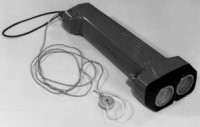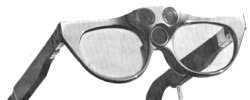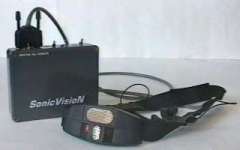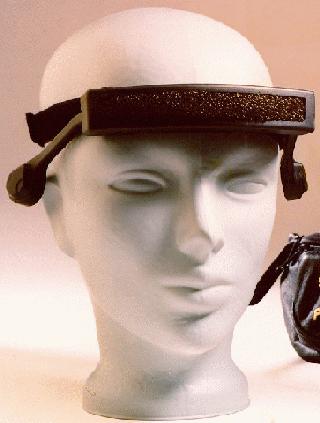
OBSTACLE DETECTORS:

-
Warn only of the presence and possibly a distance
to the object in the user's path.
PAST AND PRESENT COMMERCIAL OBSTACLE DETECTORS:
SEEING AID:
-
Emits infrared waves through in-expensive LEDs mounted
on a pair of glasses.
-
A tone is emitted when there is an object in the
user's path.
-
I.R beam is narrow allowing the user to scan their
path for objects.
LASER CANE:(~1966):
-
Long cane containing three laser beams:
-
VERTICAL: Detects objects above the waist up to 5.5ft.
away.
-
FORWARD: Detects objectsstraight ahead up to 8ft.
-
DOWN: Detects objects below the waist (curbs, stairs
etc.)
-
Three seperate tones emitted corresponding to each
beam as well as a vibrating unit for the forward beam.
MOWAT SENSOR:
-
Small hand held device.
-
Emits brief pulses of ultrasound.
-
Conveys distance to the user through vibrations (the closer an object,
the greater the vibration).
-
User may choose between two ranges - 1m and 4m.
WALKMATE: (from COBOLT Systems)
-
Simple device.
-
Hand held or can be worn with a neck strap and waist band to hold just
below the chest.
-
Not selective in its display of information (e.g. not much use in a cluttered
environment).
-
Can respond with either beeps or through the extra plug-in vibration unit.
The above description was reprinted from the following site:
http://www.netlink.co.uk/users/pia/it12_5.html
NOTTINGHAM
OBSTACLE DETECTOR (1973):
-
Hand held sonar aid informing the user of an object
within 4ft. or 8 ft.
-
Output is conveyed through vibrations (higher the
frequency, the closer the object).
-
Can be used by blind-deaf people.
 ULTRA SONIC TORCH
(1965)
ULTRA SONIC TORCH
(1965)
-
High resolution, hand held ultrasonic device.
ENVIRONMENTAL AIDS:
-
Detect objects but also provide characteristic information
about the object as well.
PAST AND PRESENT COMMERCIAL ENVIRONMENTAL
AIDS:
 BINAURAL
SENSORY AID (SONICGUIDETM) (1965):
BINAURAL
SENSORY AID (SONICGUIDETM) (1965):
-
Pair of glasses containing an ultrasound emitter
and two receivers (left, right), whose signals are fed seperately to the
corresponding ear allowing for object location to be determined through
binaural hearing.
-
Distance (up to 18ft.), is indicated by pitch, (higher
pitch = greater distance).
-
Quality of the output sound can be used to identify
the object surface, (clear sound = hard surface, fuzzy sound = rough surface).
-
Does not interfere with normal hearing.
-
Can be used to teach perceptual development to blind
infants and children.
-
Does not detect drop-offs, curbs.
 TRISENSOR
(KASPA) (1994):
TRISENSOR
(KASPA) (1994):
-
SonicguideTM mounted on a head band, with an "added
high resolution monaural sensor in order to model the dual function of
the eye (fovial and peripheral fields of view)".
-
Micro-processor controlled to generate high resolution
location of objects.
-
Locations of multiple objects in a 90o field of view.
 THE
SONIC PATHFINDER:
THE
SONIC PATHFINDER:
-
Head mounted computer controlled sonar system containing
three receivers.
-
Notes of the musical scale are output progressing
in tone as the object is approached.
-
Object to the left or right of the user causes the
tone to be heard in the respective ear whereas an object directly ahead
outputs the tone to both ears.
-
The presence of the nearest object is conveyed and
with no object present the user is informed about the proximity of the
shore-line.
-
Range is about 8ft.




 BINAURAL
SENSORY AID (SONICGUIDETM) (1965):
BINAURAL
SENSORY AID (SONICGUIDETM) (1965):
 TRISENSOR
(KASPA) (1994):
TRISENSOR
(KASPA) (1994):